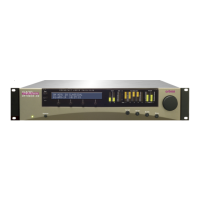6-8
TECHNICAL DATA ORBAN MODEL 9400
1. Analog Input Stages
Located on Input/Output board
The RF-filtered left and right analog input signals are each applied to a floating,
balanced amplifier that has an adjustable (digitally controlled) gain. Analog
switches set the gain. The outputs of a latch set the state of the switches. By writ-
ing data to the latch, the control circuits set the gain to correspond to what the
user specifies via the front panel controls. The gain amplifier’s output feeds a cir-
cuit that scales, balances, and DC-biases the signal. This circuit feeds an RC low-
pass filter that applies the balanced signal to the analog-to-digital (A/D) con-
verter.
Note that the small RFI “tee” filter assemblies connected to the input and output
connectors are socketed and user-replaceable.
Component-Level Description:
The left channel balanced audio input signal is applied to the filter / load net-
work made up of L100-103 and associated resistors and capacitors. (There are
solder pads available in the PC board to accept an optional 600
termination
load [R106] on the input signal if the user wishes to install one.) A conven-
tional three-opamp instrumentation amplifier (IC100 and associated circuitry)
receives the input signal. R110-114 and quad analog switch IC101 make up the
circuit that sets the gain of IC100. The switches in IC101 set the gain of the in-
strumentation amplifier by switching resistors in parallel with R104. (Smaller
total resistances produce larger gains.)
IC100 feeds IC104 and associated components. This stage balances, DC-biases,
and scales the signal to the proper level for the analog-to-digital (A/D) con-
verter IC107. IC105A and associated components comprise a servo amp to cor-
rectly DC-bias the signal feeding the A/D converter. R137-139, C109, C110
make an attenuator / RC filter necessary to filter high frequency energy that
would otherwise cause aliasing distortion in the A/D converter.
The corresponding right channel circuitry is functionally identical to that just
described.
IC100, 101, 102, 103 are socketed for easy field replacement. All other circuitry
is surface-mounted and is not field-replaceable.
2. Stereo Analog-to-Digital (A/D) Converter
Located on Input/Output board
The A/D converter, IC107, is a stereo 24-bit sigma-delta converter. (This is a sur-
face-mount part and is not field-replaceable,)
The A/D oversamples the audio, applies noise shaping, and filters and decimates
to 64 kHz sample rate. (An Orban-designed synchronous sample rate converter in
the 9400’s DSP performs the final decimation to 32 kHz. This ensures the flattest
frequency response to 15 kHz without aliasing.)

